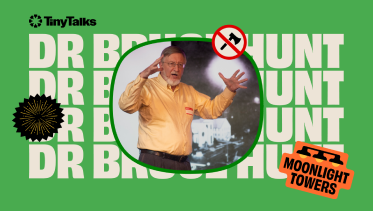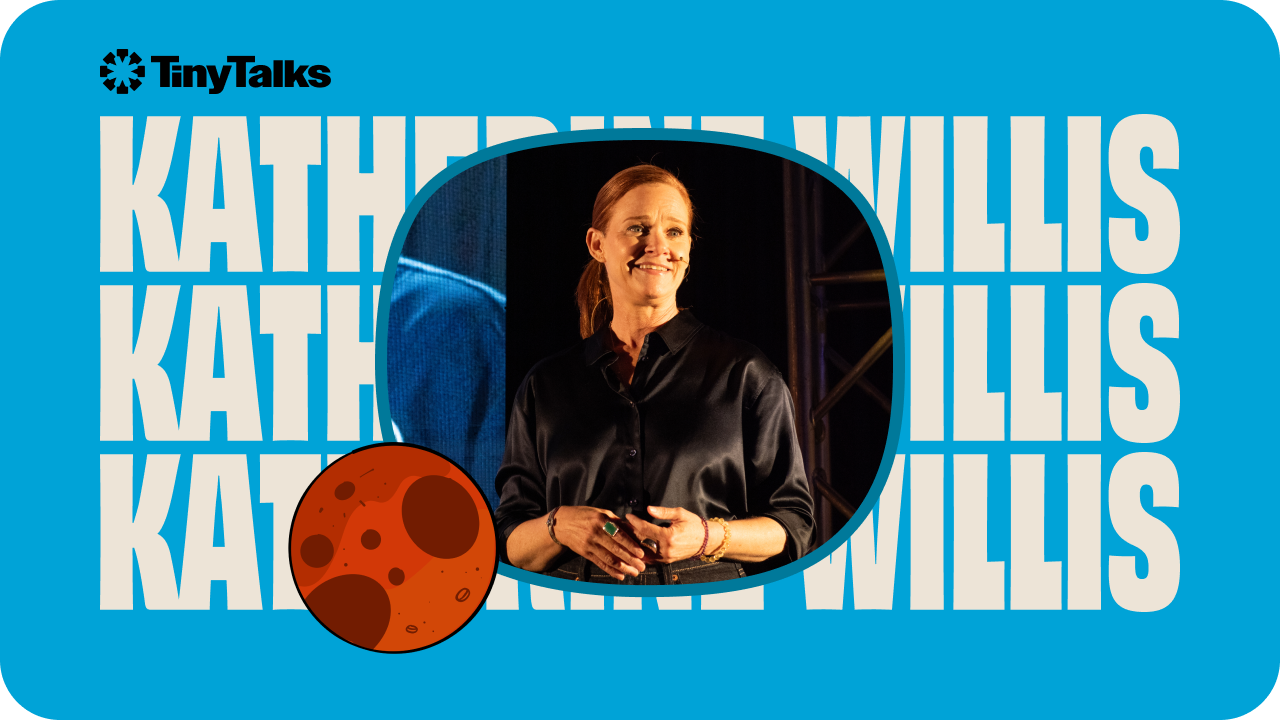Antarctica & Beyond
Transcript
So why are we here? Obviously, not here in the room, we’re listening to a bunch of great Tiny Talks, but why are there people here on earth at this point in earth history? Why in the last 100,000 years, when there’s been people around, in the context of 4.5 billion years, has there been intelligence here? What does that mean for what might be out there? So that’s been a really fascinating question for me that I’ve tried in a small way to contribute to. So why am I here? I grew up in the ’80s on the west coast at the north island of New Zealand, a place called Taranaki. We’ve got this beautiful volcano. At night, the stars just go on forever. It’s great farming country, but I am not smart enough to be a dairy farmer, so I read a bunch of books and I watched a bunch of TV on our two TV channels, and one of those was a rerun of a documentary series from the states called Cosmos by Carl Sagan.
It was full of some big ideas, and one of those big ideas was this concept put together by a radio scientist called Frank Drake. It was trying to figure out how many civilizations might be in the galaxy right now. It’s pretty simple. It’s the number of stars that form in a year multiplied by those that have planets. How many of those planets are habitable? How many of those planets go into half-life? How many of those lively planets develop intelligence? How many develop technology? And how long they survive having technology. Of course, we’ve got a data point of one. The other book I was fascinated by was this novel about the distant future of 2010. It’s about an international mission to Jupiter, and as part of the adventure, they find life on this icy moon called Europa, where even back then they knew there was this ocean of water underneath this ice shell of this tiny little moon the size of our own.
And so fast-forward 20 years, I’m back in New Zealand. I’ve got a PhD on the geology of Venus and I’m unemployed and my visa has expired. But it turns out the U.S. Antarctic program goes through New Zealand on the way to Antarctica. So I get picked up sight and seen by the University of Texas Institute for Geophysics where it’d been ever since and thrown into Western Antarctica. We were there to survey Thwaites Glacier. It was unexplored at the time. It was the size of New Mexico and we were surveying it with these tiny little airplanes, 300 miles out and back. The weather is atrocious. We were down there for four months. I missed my brother’s wedding. You can see the accommodation was really luxurious. But I got to go on 35 of 80 flights operating the ice penetrating radar. So what’s that about? How does that work?
Well, it turns out that ice is transparent to radio waves. So if we send out a radio transmission, when we listen for the echoes coming back, and we do that 6,000 times a second, as the plane moves along, we can make a scan of the subsurface of the ice sheet. And what we found at Thwaites Glacier is that there is an enormous valley under there that goes a mile below sea level right on the ocean. And the valley’s so big you could lose the Grand Canyon at it. It’s tiny. But the ocean is trying to push in underneath it and melting away at the edge. And if it was to collapse, which it may be doing, it would raise sea level around the United States by about 13 feet. Now, if that’s due to greenhouse gases, that would be part of that last part of the Drake equation. How long can civilizations last?
Western Antarctica is only 10% of the sea level potential of Antarctica. Most of it is in Eastern Antarctica, which is the size of the United States, so we needed to deal with that problem. And to get around the United States, you need to airline it. So we needed to upgrade the play. So we went with the DC-3. The DC-3 was first developed back in the 1930s, the first real airliner, and they were built by the thousands in the Second World War. They stopped making them in 1945 for obvious reasons, but they’re so robustly put together that the last forever. We’ve used aircrafts that were involved in D-Day. So one of the things that we’re looking for in Eastern Antarctica is what we call old ice. And why do we care about old ice? Well, it turns out humans have a long relationship with ice in general.
Back in the last 200,000 years, when modern humans came into being, there was miles of ice over Canada and that ice sucked up the water out of the oceans and dropped it down over 400 feet at times. So how do we know about this record of ice on earth? Well, it turns out when you get snow landing on the ice sheet and it compresses down the layers, that traps little bubbles of the atmosphere in there. And so that gets buried in the ice and then we can drill down, and basically play it back as like a tape recording, get measurements of the ice volume, of the temperature, and of what the greenhouse gases were doing at the time. So we have a good understanding back about 800,000 years, and we know that there’s been eight of these enormous ice ages over that time. And then we run out of ice, which is exactly where it gets interesting because the ice ages seem to go to every 40,000 years, rapid, enormous environmental change happening on not a geological time-scale, but nearly a generational time-scale.
And you had to be pretty smart to survive an environment like that that’s changing rapidly all the time. And that happened to correspond when humans were starting to radiate out of Africa. And then if you think about the context of all over Earth history, it’s really unique the last million years or so in the context of this 4.5 billion years. It’s really the only time that we’ve had abundant life on land, that we’ve had these big unstable ice sheets at the poles, and we’ve had continents spread out across the earth with large amounts of coastlines sensitive to sea level change. So was that what prompted intelligence on this planet? Maybe. So to find old ice, we have to go into the deepest parts of Eastern Antarctica. That’s where you need to be high, cold. It’s pretty dry. Over 10,000 feet, your brain is trying to explode. It’s minus 45 degrees Fahrenheit on a good day.
But we were successful a few years back working out of the European station that’s at Dome C working with the Australians. And we went and did a survey and both Europeans and Australians and now digging their basic tape recorders, ice cores down into the ice sheet. However, the ice is so complicated at the bottom that you wouldn’t believe a record from a single place. So for the past two winters, summers in the Southern Hemisphere, we’ve been working out to the U.S. base at the South Pole, which is a pretty exotic place. You can talk to me afterwards about it. But we have been surveying the area the size of Montana, looking for a place for a future U.S. ice core inside as part of an NSF project called [inaudible 00:07:03]. One of the things we’re looking for is where the old ice might be getting destroyed.
So if you put ice under too much pressure, it actually starts to melt, especially if you’ve got a little bit of heat coming from the ground. You form lakes down there and those lakes would obviously be destroying this old ice at the bottom of the record. But they’re interesting in their own right because where you’ve got water, you could [inaudible 00:07:25]. Now, about 10 years ago, we proposed to put that ice penetrating radar that had been flying under that 1945 plane onto a new deep space mission. And it’s been about 10 years of a lot of work, but this October we’ll be launching from Florida for the planet Jupiter. And seven years from tonight, we’ll be returning the first radar data from Europa looking for the lakes in the ice shell and seeing how the ocean underneath communicates with the ice shell and might foster a habitable environment.
And on the side of Europa Clipper is this plate. It was actually unveiled at South by Southwest a few weeks ago. It’s got a poem by a poet laureate about water. It’s got the names of millions of people on a little chip on the side. But it’s also got an etching of the Drake equation. It’s nice when things come full circle. Thank you.


















































